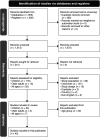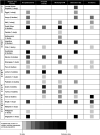Respiratory syncytial virus burden in children under 2 years old in understudied areas worldwide: gap analysis of available evidence, 2012-2022
- PMID: 39639952
- PMCID: PMC11617186
- DOI: 10.3389/fped.2024.1452267
Respiratory syncytial virus burden in children under 2 years old in understudied areas worldwide: gap analysis of available evidence, 2012-2022
Abstract
Background: We evaluated published evidence (2012-2022) on pediatric RSV burden in 149 countries within World Health Organization (WHO) regions of Africa (AFRO), Americas (AMRO, excluding Canada and the USA), Eastern Mediterranean (EMRO), Europe (EURO, excluding European Union countries and the UK), Southeast Asia (SEARO), and Western Pacific (WPRO, excluding Australia, China, Japan, New Zealand, and South Korea).
Methods: Gap analysis on RSV-associated disease (hospitalizations, hospital course, mortality or case fatality, detection, and incidence) in children ≤2 years old, where hospitalization rates, hospital course, mortality rate, case fatality rate (CFR), and postmortem detection rates were summarized, by region, for each country.
Results: Forty-two publications were identified covering 19% of included countries in AFRO, 18% in AMRO, 14% in EMRO, 15% in EURO, 18% in SEARO, and 13% in WPRO. Methods, case definitions, and age groups varied widely across studies. Of these 42 publications, 25 countries reported hospitalization rate, hospital course, mortality rate, CFR, and/or postmortem detection rate. RSV hospitalization rate (per 1,000 children per year/child-years) was higher among ≤3-month-olds (range, 38 in Nicaragua to 138 in the Philippines) and ≤6-month-olds (range, 2.6 in Singapore to 70 in South Africa) than in 1-2-year-olds (from 0.7 in Guatemala to 19 in Nicaragua). Based on 11 studies, in AFRO (South Africa), AMRO (Chile and Mexico), EMRO (Lebanon and Jordan), EURO (Israel and Turkey), and SEARO (India), hospitalized children ≤2 years old remained hospitalized for 3-8 days, with 9%-30% requiring intensive care and 4%-26% needing mechanical ventilation. Based on a study in India, community-based CFR was considerably higher than that in the hospital (9.1% vs. 0% in ≤3-month-olds; 7.1% vs. 2.8% in ≤6-month-olds).
Conclusions: National and regional heterogeneity of evidence limits estimates of RSV burden in ≤2-year-olds in many WHO region countries, where further country-specific epidemiology is needed to guide prioritization, implementation, and impact assessment of RSV prevention strategies.
Keywords: bronchiolitis; gap analysis; hospitalization rate; infants; lower respiratory tract infections; mortality; pneumonia; respiratory syncytial virus.
© 2024 Sini de Almeida, Leite, Atwell, Elsobky, LaRotta, Mousa, Thakkar and Fletcher.
Conflict of interest statement
RS, JA, ME, JLR, MM, KT, and MF are employees of Pfizer. JL is an employee of IQVIA, which received funding from Pfizer in connection with the development of this article and conducting the research.
Figures


References
-
- Shi T, McAllister DA, O’Brien KL, Simoes EAF, Madhi SA, Gessner BD, et al. Global, regional, and national disease burden estimates of acute lower respiratory infections due to respiratory syncytial virus in young children in 2015: a systematic review and modelling study. Lancet. (2017) 390(10098):946–58. 10.1016/S0140-6736(17)30938-8 - DOI - PMC - PubMed
-
- Li Y, Wang X, Blau DM, Caballero MT, Feikin DR, Gill CJ, et al. Global, regional, and national disease burden estimates of acute lower respiratory infections due to respiratory syncytial virus in children younger than 5 years in 2019: a systematic analysis. Lancet. (2022) 399(10340):2047–64. 10.1016/S0140-6736(22)00478-0 - DOI - PMC - PubMed
-
- U.S. Centers for Disease Control and Prevention (CDC). RSV in Infants and Young Children. U.S. Centers for Disease Control and Prevention (CDC) (2024). Available online at: https://www.cdc.gov/rsv/infants-young-children/index.html (accessed June 1, 2024).
-
- Vartiainen P, Jukarainen S, Rhedin SA, Prinz A, Hartonen T, Vabalas A, et al. Risk factors for severe respiratory syncytial virus infection during the first year of life: development and validation of a clinical prediction model. Lancet Digit Health. (2023) 5(11):e821–30. 10.1016/S2589-7500(23)00175-9 - DOI - PubMed
-
- Suh M, Movva N, Jiang X, Bylsma LC, Reichert H, Fryzek JP, et al. Respiratory syncytial virus is the leading cause of United States infant hospitalizations, 2009–2019: a study of the national (nationwide) inpatient sample. J Infect Dis. (2022) 226(Suppl 2):S154–63. 10.1093/infdis/jiac120 - DOI - PMC - PubMed
Publication types
LinkOut - more resources
Full Text Sources
Miscellaneous

